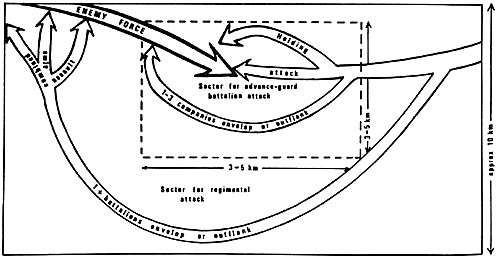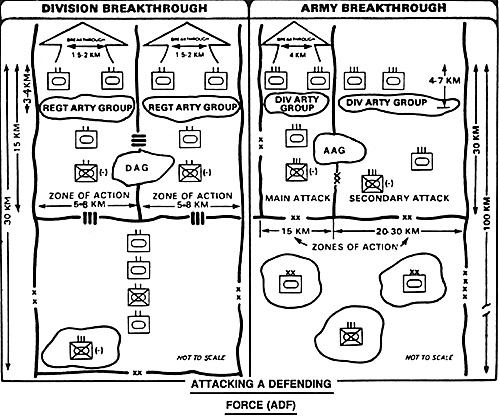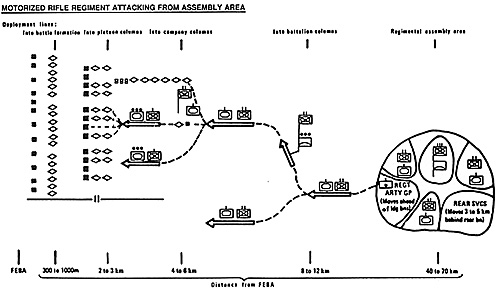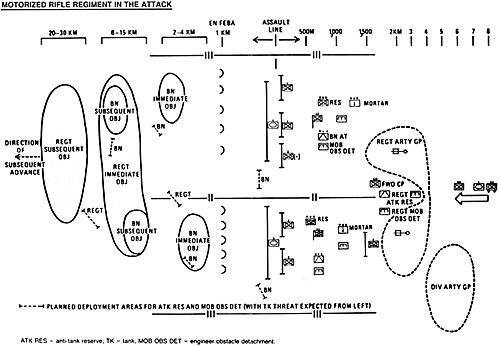The Soviet Army doctrine focuses on centralized planning of offensive operations. The offensives will be executed by units in echelon following proven, reliable battle drill. The Soviet doctrine relies little on the flexibility and initiative of subordinate units and leaders. The advance to a planned objective is expected to be maintained at all costs. This doctrine is relatively unchanged from the tactics that left them victorious in World War Il. Several revisions have been made, however, to address tactical nuclear weapons and the increased capabilities of modern weapons.
Soviet doctrine has three separate levels: Strategic, which applies to operations on a national or theater level; Operational, which applies to operations on a Front or Army level; and Tactical, which applies to operations at the division level and below. Military art governs the Strategic and Operational levels, while only tactics are used at the tactical level.
The Soviet Union includes several different ethnic and cultural groups. This diversity produces an army that has language problems and varied education levels among its soldiers. More importantly, the Soviet Army has no professional noncommissioned officer corps. Soviet NCOs are selected from among the recruits; their term of appointment is equal to their term of enlistment. While the NCOs may prove to to be the superior soldiers in the unit, they have no strong base of experience from which to train other soldiers. The officers are chosen as much for their political membership in the communist party as for ability or quality of character. An army with this level of experience must rely on simple battle drills in training and combat.
The Soviet soldier is well-trained in the tactics he is capable of executing, but he is not the superman portrayed in some quarters. The turnover in Soviet units is high, leading to a constant need for retraining. The life of a Soviet soldier has produced a reportedly rampant problem with alcoholism. Despite this, the quality of the Army will increase due to the battlefield experience being gained in Afghanistan.
Above the division level, Soviet commanders have a lot of freedom of action. However, the use of simple battle drills is integral to Soviet doctrine at the division level and below. Procedures are designed, trained, and executed for different battlefield situations. Subordinate leaders do not develop a scheme of maneuver upon encountering the enemy. Instead, the appropriate battle drill lays out the response which is executed automatically. Faced with like situations, different units will react similarly, if not identically. This concept of battle drill is utilized from the smallest unit up. Soviet commanders below the regimental level make few battlefield decisions.
Weapons
The Soviet Army's weapons fill the needs of its doctrine. Their weapons are designed to be mass-produced weapons requiring less training to employ and maintain. They have a numerical superiority in land forces and can afford to avoid more complex systems required to fight a superior force and win. This approach to weapons design supports the Soviet doctrine of simple battle drills and makes less demand on Soviet technology.
These "simple" weapons, however, are very effective and lethal. In fact, certain technological advances have made some Soviet weapons superior to those of the U.S. Their armored vehicles are gunned to provide maximum firepower and present very low silhouettes. Sacrifices are made in the area of crew comfort and storage of ammunition and fuel. Soviet vehicles do not feature the third generation night vision devices of the West. They also have inferior communications capabilities but this is in keeping with their doctrine - the vehicles do not need to commu- nicate much to execute their drills.
The Soviets have an evolutionary approach to weapons production, contrasting the West's revolutionary style of development. The West will seldom introduce new weapons, but when it does, it will be a major redesign. For the Soviets, improved models of current weapons are introduced periodically. This system minimizes the impact of training units in the use of the new weapons. For example, current Soviet tank units feature several different tanks evolved from the same basic design. All have some shortcomings when compared to the latest Western equivalents, but all are fully capable of successfully executing the current Soviet doctrine.
Offensive
As stated earlier, the Soviets emphasize the offensive, viewing this as the most economical way of ending a war. They will attempt to seize the initiative immediately and maintain it for the duration. Operational doctrine states that units in a Front or Army maintain maximum dispersion.
 Meeting Engagement
Meeting Engagement
At the Tactical level, the Soviets will make maximum use of their superiority in numbers. Massive pre-planned artillery barrages will soften up targets before attacks attempt to overwhelm the outnumbered defenders. The units will strive to maintain the advance toward their assigned objectives. Soviet units are designed to be consumed in combat rather than sustained like their Western counterparts. This thinking is better suited to offense than defense; it also allows for a smaller support tail.
The Soviets use echeloned formations to assist in maintaining the advance and to allow maximum dispersion on the nuclear battlefield. By doctrine, this dispersion is more apparent above the division level. The first echelon unit will attempt to advance along its assigned axis. If opposition is encountered, every effort will be made to reduce or bypass the enemy. If the attack bogs down or fails, the second echelon will either continue the attack or bypass the positions to continue the advance. At all levels, keeping the advance going is all- important.
 Attacking a Defending Force
Attacking a Defending Force
Soviet offensives are classified into three types, based on what the enemy is doing. The first type is Attacking a Defending Force (ADF). This type of attack, formerly referred to as a breakthrough, is aimed at enemy units who are holding their positions. The Soviets feel, however, that an ADF is the least desirable option to employ during their advance. The second type of attack is the Meeting Engagement, when the enemy is advancing toward Soviet forces. The third type is the Pursuit, aimed at an enemy who is withdrawing. The Soviets will weight their attacks at the tactical level in key areas to yield a major advance toward a key objective. These attacks will receive additional support. Other supporting attacks will also be conducted to confuse the enemy and to pin his units along the front. If the advance is halted, a prepared ADF attack will be conducted. An ADF attack receives maximum support, and will try to reduce key enemy positions as rapidly and completely as possible.
There is no reason to doubt that the Soviets will employ their sizable chemical arsenal. The Soviets see no clear distinction between conventional warfare and that using chemical or nuclear weapons. Their units train extensively in a chemical environment. Units on the offense suffer less from the effects of chemical weapons if they continue to move. The use of persistent agents against Western defenses will be particularly effective. If used in conjunction with an attack, the shock effect against the defenders is magnified.
The offensive will be halted only temporarily and will be resumed by another echelon as rapidly as possible. Defensive doctrine allows the holding of recently gained ground only until the offensive is renewed. Units in defensive positions will be understrength from having failed in the advance. Other units will move through or around the defending units to resume the attack. The Soviets view time spent on the defensive as valuable time wasted in meeting their aggressive time schedules.
All levels of Soviet organization will follow these doctrinal guidelines. The basic Soviet unit of maneuver is the regiment. Regiments usually move in a divisional formation, but are the smallest unit capable of limited, independent operation. Battalions maneuver as part of the regimental formation. Except during an ADF attack, Soviet regiments usually maneuver with battalions in echelon. Companies and platoons do not maneuver independently, but only within the battalion, where a rigid formation is utilized.
Motorized Rifle Division
A Soviet motorized rifle division conducting a movement to contact moves in march column formation: all elements in trail, one behind the other. The divisional reconnaissance element will precede the first echelon regiment's advance guard by one day. The recon battalion will probe enemy positions along a frontage of 15 to 25 kilometers. It will attempt to identify enemy positions and holes or weak points in their lines. The first echelon regiment's lead battalion is reinforced and acts as the regimental advance guard.
 Motorized Rifle Regiment Attacking from an Assembly Area
Motorized Rifle Regiment Attacking from an Assembly Area
Jumbo Motorized Rifle Regiment Attacking from an Assembly Area (84K)
The reinforced motorized rifle battalion will have the following assets: three motor rifle companies, one tank company, an anti-tank company with nine modified BRDMs armed with AT5 ATGMs, a self-propelled artillery battalion of eighteen Su-122 122mm howitzers, a 120mm mortar company, an air defense section with two ZSU-23(4)s, an engineer platoon, an NBC platoon, and several support elements.
A reinforced tank battalion would consist of three tank companies, a motorized infantry company, a self-propelled artillery battalion, air defense section, engineer platoon, and an NBC platoon. An anti-tank element is not included because of the higher number of tanks. The engineer platoon may include bridging equipment, mine clearing equipment, and bulldozers.
A Soviet motorized rifle battalion acting as regimental advance guard would organize into three elements. A reinforced rifle platoon, termed the combat recon patrol, would lead the advance. The platoon would be reinforced by an engineering recon element and a chemical recon element, both in BRDMs.
Twenty minutes behind this platoon would follow the forward security element, composed of the remainder of the reinforced rifle company. In addition, the forward security force would contain a tank platoon, six Su-122s howitzers, an anti-tank element of three BRDMs, engineers, and a chemical squad. The battalion commander may position the air defense section and the mortar company with the forward elements at his discretion. The advance guard main force, containing the remainder of the battalion follows an hour behind the lead platoon. The rest of the regiment follows one to two hours behind the lead battalion. The regimental advanced guard maintains this formation until contact is made.
When contact occurs, the lead units will deploy into a hasty attack formation and attempt to reduce the defending units rapidly, or bypass the position. If the position can't be reduced or bypassed, the different elements of the advance guard may attempt to attack without waiting for the remainder of the battalion. The size of the enemy positions dictates the size of the attacking force. To conduct an attack, the battalion occupies an attack position and assumes an attack formation. A Soviet battalion attacks in a formation one to one and a half kilometers in frontage and three kilometers in depth.
The motorized rifle battalion attacks with a tank company in the lead, its main battle tanks on line. Two hundred meters behind the tank company, two motorized rifle companies attack abreast, with all vehicles on line. The battalion command group follows. Four hundred meters behind the tanks are the artillery, mortar, anti- tank, engineer, and chemical units arrayed for two kilometers. The final five hundred meters in depth are occupied by the third motorized rifle company.
A tank battalion attacks with two tank companies abreast in the lead, with the tanks on line. Two hundred meters behind the tanks is the motorized rifle company. The battalion command group follows behind the infantry, with the support elements arrayed behind them. The third tank company brings up the rear.
Infantry may dismount immediately, ride until within small arms range of the enemy before dismounting, or attack mounted. Infantry is more effective within small arms range if dismounted, but Soviet BMPs permit a relatively high volume of fire from the comparative safety of the vehicle. As soon as a unit is on line, it advances on the enemy positions, firing from the short halt. If the attack succeeds in defeating the enemy units the advance can quickly resume. If the attack does not displace the defenders, the unit will continue to engage the enemy, pinning them and allowing the second echelon to bypass and continue the advance. If the other echelons cannot bypass, the advance will be halted.
A deliberate attack will be launched against the defensive positions as quickly as possible. The deliberate attack will be supported by an artillery barrage and air power. The elements of a unit will attack on line from an attack position. As the unit attacks, it will advance in formation with its vehicles firing from a short halt. If it has not done so already, the infantry will dismount within small arms range of the defenders. Deliberate attacks are used against defenses that a commander deems capable of being reduced by his unit. If the deliberate attack fails, a full ADF attack may be launched. If the defenders are too strong, the attack may be shifted elsewhere.
 Motorized Rifle Regiment in Attack
Motorized Rifle Regiment in Attack
Jumbo Motorized Rifle Regiment in Attack (81K)
An ADF attack is a maximum support effort designed to destroy enemy positions in a key area, allowing a breakthrough to the enemy rear. To conduct an ADF attack, the Soviet ground forces use the same formations as a deliberate attack, but the level of artillery fire and close air support is greatly increased. The intent of the type of attack, usually aimed at a weak sector, is to produce an opening in the enemy lines for penetration by second and third echelon units when no other option is available. After such an attack, the advance becomes a Pursuit. The Soviets view a pursuit as the decisive and most desirable engagement. When contact is reestablished with organized defensive forces, the pursuit ends.
Defense
When the Soviets are forced onto the defensive temporarily, they use a strongpoint defense. Units anchor themselves in strongpoints, usually on hills, and create killing zones between them. Any attempt to move between strongpoints places enemy units within this killing zone, allowing maximum firepower to be brought to bear. Strongpoints are established in the most defensible and mutually-supporting positions possible.
The units occupying defensive positions will seldom resume the offensive. Another echelon will perform that task. The defensive unit is usually depleted from having attacked and failed to displace nearby enemy forces. As with any units on the defensive, the Soviets will continue to improve their positions as long as they occupy them. Minefields, obstacles, and entrenchments will be added with enough time. Despite their emphasis on offensive operations, they are very adept at creating strong defensive positions.
The Soviet Army makes extensive use of its large quantity of artillery. Their battalions all have self-propelled companies that maneuver with them, supplying immediate suppression. Each echelon of the Soviet command has ample artillery assets at its disposal. Soviet doctrine calls for massive, preplanned artillery barrages prior to its attacks. ADF attacks, if they must be conducted, receive heavy support. Soviet indirect fire and air support is used to achieve mass at the Operational level. At this level, mass is achieved by quantity, not quality. The Soviets do not have the technologically advanced munitions of the Western armies, but have sufficient numbers of tubes to produce an enviable degree of indirect fire support for its forces.
Soviet airpower is very dedicated to the role of ground support. Several aircraft designs are strictly intended for ground attack missions. While NATO is generally expected to eventually gain air superiority if war breaks out, enough interceptors and ground attack aircraft are in the Soviet inventory to ensure at least air parity and a minimal level of close air support during the initial stages of a war.
The Soviet Army also has very capable air defense forces. A wide number of modern, effective Surface-to-Air (SAM) systems will be deployed with any Soviet ground force. While SAMs are susceptible to countermeasures, the quantity and quality of the air defenses commands a great deal of respect. The ZSU-23(4) air defense gun system, especially, will make life difficult for enemy helicopters on the battlefield.
Soviet engineering forces are strongly oriented to bridging the water obstacles in West Germany. The high number of unfordable north-south streams and rivers make such a capability mandatory if the Soviets are to keep the initiative and meet their aggressive attack time schedules. The engineers are also capable of supporting units with the emplacement or clearing of obstacles and minefields.
Soviet battle doctrine is straightforward and relies heavily on large numbers of effective forces. The Soviet Army definitely has the quantities of weapons, units, and soldiers to implement its strategy. With capable weapons and possible operational initiative, any smaller force which hopes to stop the Soviet juggernaut will need a superior doctrine, effectively employed.
More Modern Battle Doctrine
- Introduction
Objectives and Doctrine
Weapons and Doctrine
Terrain and Doctrine
Soviet Army Doctrine
US Doctrine: AirLand Battle
Back to Table of Contents: CounterAttack #1
To CounterAttack List of Issues
To MagWeb Master Magazine List
© Copyright 1987 by Pacific Rim Publishing Company.
This article appears in MagWeb (Magazine Web) on the Internet World Wide Web.
Other military history articles and gaming articles are available at http://www.magweb.com